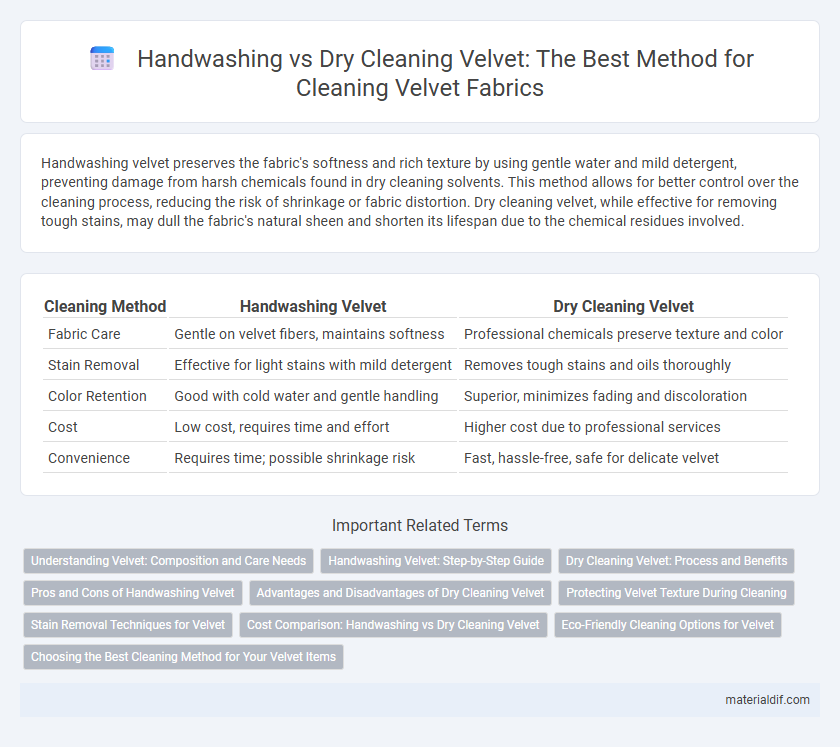Handwashing velvet preserves the fabric's softness and rich texture by using gentle water and mild detergent, preventing damage from harsh chemicals found in dry cleaning solvents. This method allows for better control over the cleaning process, reducing the risk of shrinkage or fabric distortion. Dry cleaning velvet, while effective for removing tough stains, may dull the fabric's natural sheen and shorten its lifespan due to the chemical residues involved.
Table of Comparison
| Cleaning Method | Handwashing Velvet | Dry Cleaning Velvet |
|---|---|---|
| Fabric Care | Gentle on velvet fibers, maintains softness | Professional chemicals preserve texture and color |
| Stain Removal | Effective for light stains with mild detergent | Removes tough stains and oils thoroughly |
| Color Retention | Good with cold water and gentle handling | Superior, minimizes fading and discoloration |
| Cost | Low cost, requires time and effort | Higher cost due to professional services |
| Convenience | Requires time; possible shrinkage risk | Fast, hassle-free, safe for delicate velvet |
Understanding Velvet: Composition and Care Needs
Velvet, typically made from silk, cotton, or synthetic fibers, requires precise care due to its dense pile and delicate texture. Handwashing velvet with gentle detergent preserves its softness and prevents damage to the fabric's pile, while dry cleaning uses chemical solvents that effectively remove tough stains without water exposure. Understanding the fiber composition helps determine the best cleaning method, as natural velvets tolerate handwashing better, whereas synthetic or mixed fibers often benefit from professional dry cleaning.
Handwashing Velvet: Step-by-Step Guide
Handwashing velvet requires gentle care to maintain its texture and appearance; start by filling a basin with cold water and a small amount of mild detergent specially formulated for delicate fabrics. Submerge the velvet garment carefully, gently agitating the water to loosen dirt without rubbing or wringing, then rinse thoroughly with cold water to remove all soap residues. Lay the velvet flat on a clean towel and roll it to absorb excess moisture, then reshape and air dry away from direct sunlight to prevent fabric damage or color fading.
Dry Cleaning Velvet: Process and Benefits
Dry cleaning velvet preserves the fabric's rich texture and vibrant color by using gentle solvents that prevent water damage and shrinkage common in handwashing. This process effectively removes deep-set stains and maintains the velvet's plushness, extending the lifespan of garments and upholstery. Professional dry cleaning ensures optimal care for delicate fibers, avoiding distortion and maintaining the luxurious appearance of velvet over time.
Pros and Cons of Handwashing Velvet
Handwashing velvet preserves the fabric's delicate texture and reduces the risk of damaging the pile, making it a gentle option for light stains or spot cleaning. It requires careful use of cold water and mild detergent to avoid shrinkage, color fading, or distortion, which can occur if improperly handled. However, handwashing velvet can be time-consuming and may not effectively remove heavy soiling, often necessitating professional dry cleaning for deep cleanse and fabric longevity.
Advantages and Disadvantages of Dry Cleaning Velvet
Dry cleaning velvet preserves the fabric's texture and sheen by using gentle solvents that minimize water damage, making it ideal for delicate or antique velvet items. However, the process can be costly and may involve chemicals that pose environmental and health concerns. Unlike handwashing, dry cleaning reduces the risk of fabric shrinkage and color bleeding but offers less control over the cleaning process.
Protecting Velvet Texture During Cleaning
Handwashing velvet with cold water and mild detergent preserves the fabric's plush texture and prevents fibers from matting, ensuring the velvet maintains its softness and sheen. Dry cleaning velvet involves professional solvents that clean deeply without saturating the fabric, reducing the risk of water damage and preserving the pile integrity. Choosing the correct cleaning method protects velvet's rich texture and vibrant appearance, extending the garment's lifespan while maintaining its luxurious feel.
Stain Removal Techniques for Velvet
Handwashing velvet allows for gentle stain removal using mild detergents and cold water, preserving the fabric's delicate texture and pile. Dry cleaning velvet utilizes specialized solvents that penetrate fibers without water, effectively lifting oil-based stains and preventing shrinkage or color fading. For optimal stain removal, professional dry cleaning is preferred for severe or set-in stains, while handwashing is suitable for fresh, light stains to maintain velvet's softness and sheen.
Cost Comparison: Handwashing vs Dry Cleaning Velvet
Handwashing velvet typically incurs lower costs compared to dry cleaning, with expenses mainly limited to mild detergent and water, making it a budget-friendly option for regular maintenance. Dry cleaning velvet involves professional services that can cost three to five times more per garment, reflecting specialized cleaning techniques to preserve fabric integrity and prevent damage. Choosing between handwashing and dry cleaning depends on fabric type and maintenance frequency, but handwashing remains the most economical for everyday care.
Eco-Friendly Cleaning Options for Velvet
Handwashing velvet uses gentle water and biodegradable detergents, minimizing chemical runoff and reducing environmental impact compared to traditional dry cleaning methods, which often rely on harmful solvents like perchloroethylene. Eco-friendly handwashing helps preserve velvet's delicate fibers while promoting sustainable garment care by decreasing energy consumption and toxic waste production. Choosing handwashing over dry cleaning supports greener velvet maintenance practices and contributes to a healthier planet.
Choosing the Best Cleaning Method for Your Velvet Items
Handwashing velvet preserves the fabric's texture and allows for gentle removal of surface dirt by using mild detergent and cool water, ideal for delicate or smaller velvet items. Dry cleaning velvet offers professional stain removal and deep cleaning without risking shrinkage or damage, making it suitable for structured garments or heavily soiled pieces. Choosing the best cleaning method depends on the velvet type, item construction, and care label recommendations to maintain softness and extend the lifespan of the fabric.
Handwashing Velvet vs Dry Cleaning Velvet Infographic

 materialdif.com
materialdif.com